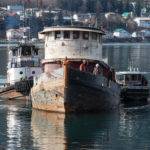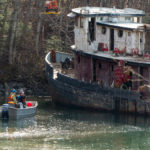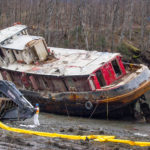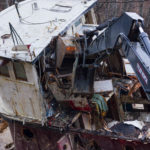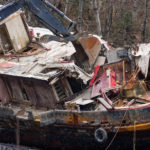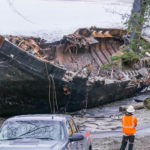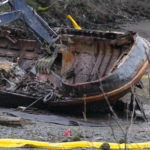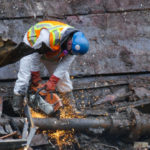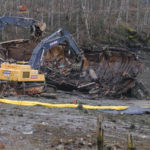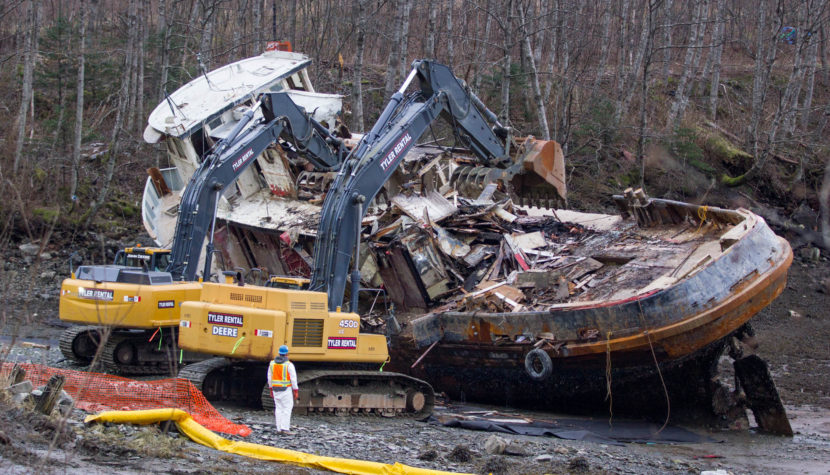
The old tugboat Challenger is no more. The 71-year-old wooden vessel that became a Seattle bunk-and-breakfast and later a home for a Juneau family has been dismantled and disposed.
The 96-foot vessel, which sank in Gastineau Channel last September, was raised by contractors last month and towed to the AJ Dock on the downtown waterfront. Contractors removed oil, fuel, and other hazardous materials before beaching the vessel just south of the rock dump. Excavators destroyed the vessel and piled the remains on the edge of the rock dump nearby. On Wednesday, as much as 150 tons of woody debris was stacked up before it was hauled away to the Juneau landfill.
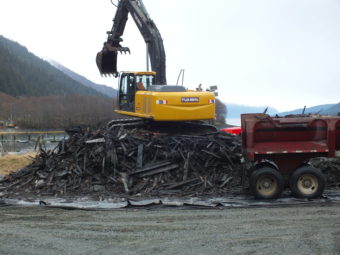
“The Challenger is gone. This is the remnants of the hull,” said Cmdr. Patrick Hilbert, the U.S. Coast Guard’s incident commander for the operation as he pointed to a giant pile in front of him. “The metal parts are disposed of.”
Metal products and parts, such as the tug’s engine, will be recycled by Skookum Sales & Recycling. Southeast Alaska Lighterage disposed of petroleum products and hazardous materials were transported to the city’s hazardous materials disposal facility.
Over 430 gallons of diesel fuel and lube oil were removed from the old tug. Contractors also removed over a ton of lead acid batteries and nearly 2,900 pounds of materials containing asbestos.
Hilbert said the operation went well with contractors and various government agencies cooperating and working together.
Hilbert said the estimated $2 million operation was well worth it.
“Between the oil and the hazmat, we did the right thing to take this action to remove it from Gastineau Channel, and remove that environmental threat from the wetlands and the salmon hatchery,” Hilbert said.
The Challenger sank just south of the Mendenhall Wetlands State Game Refuge and Douglas Island Pink and Chum facility.
Listen to an interview with U.S. Coast Guard Cmdr. Patrick Hilbert:
Funds for the operation will come from the national Oil Spill Liability Trust Fund. Hilbert said some of the biggest costs included the use of crane barge Brightwater, as many as 45 people working during the six-week operation, and the per-pound disposal costs of the woody debris at the Juneau landfill.
Hilbert said they did not find any conclusive evidence of how the vessel sank last September. There were pumps found on board the derelict vessel, but it was impossible to determine if any had failed.
The hull planking and large timbers, which contractors cleaned of oily residue at the AJ Dock, splintered easily during the demolition. Hilbert said that was a sign that the wood hull was already beginning to rot.
Hilbert said they’ll now focus on demobilizing Coast Guard personnel and others who were assigned to the operation.
- Approximately 300,000 pounds of woody debris
- 2,893 pounds of materials containing asbestos
- 2,467 pounds of lead acid batteries
- 1,540 gallons of oily water
- 550 pounds of hazardous waste like paint, fire extinquishers, waste oil, polyester resin and grease
- 437 gallons of petroleum products like diesel fuel and lube oil
- 1 refrigerator
- 1 freezer

